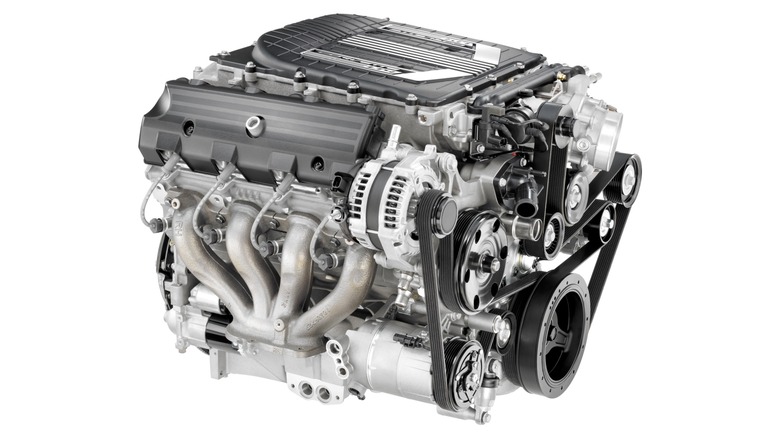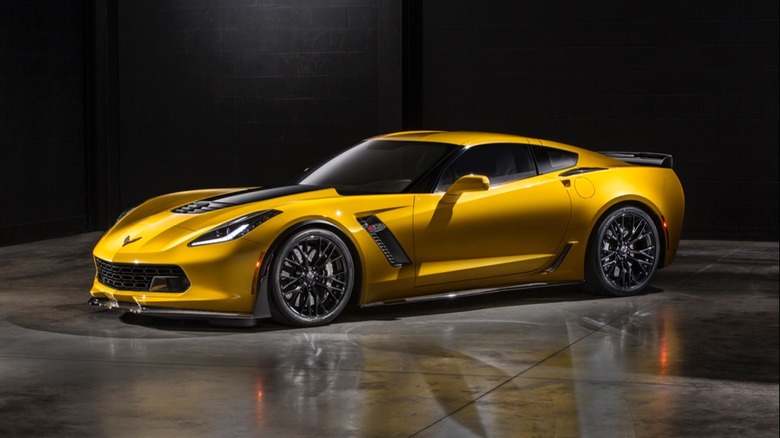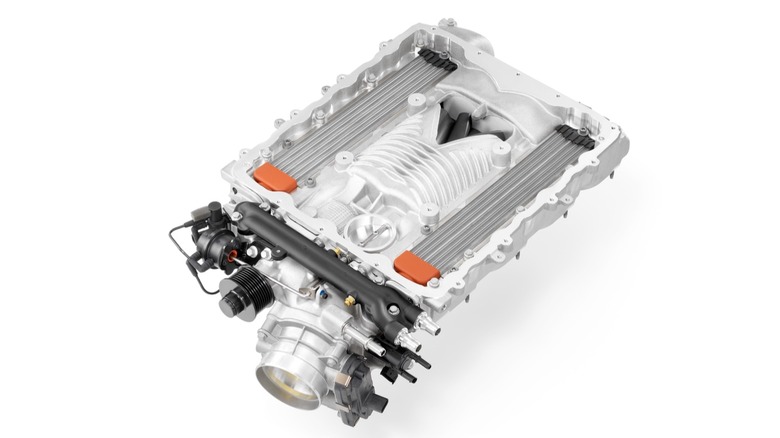Which Cars Have GM's 6.2L LT4 Engine Under The Hood & How Much HP Does It Have?
While GM's LS small-block engine series might be the most celebrated V8 recipe on the face of the planet, all good things must come to an end. Who says that those good things can't be replaced with great things? That must've been a question that GM engineers asked themselves while working on the Gen V LT engines that took the reins from the mythical LS engine series with massive displacement to fill. They didn't disappoint.
While the initial LT1 was a solid introduction to the Gen V GM small-block, the supercharged 6.2L LT4 is the engine that got everyone excited. When the LT4 was released in the 2015 Corvette Z06, it was the most powerful engine that GM had placed under the hood of any production vehicle in its entire 107-year history. With 650 horsepower and an equal amount of torque on tap, the LT4 was a certified showstopper.
In the GM engine catalog, the LT4 name has always represented an additional step beyond extraordinary. Some newer GM enthusiasts might not realize that the supercharged 6.2L Gen V was actually the second engine to wear the LT4 name.
Its predecessor was a part of GM's Gen II small-block engine series and was an important engine in its own right. The Gen II LT4 was released in 1996 for the last year of the C4 Corvette's production as a final send-off to not only the C4 but to the pre-LS small-block formula as well. Like the Gen V LT4, the Gen II variant was a 'hot' version of that generation's LT1 V8, featuring optimized heads, a more aggressive cam, and a higher compression ratio. The changes brought its pony count up to a conservatively rated 330 horsepower.
Which cars have the GM LT4 under the hood?
With an output of 650 horsepower and 650 lb-ft of torque, the Gen V LT4 wasn't an engine designed for minivans. No, it was built for the best of what GM had to offer at the time, and the best only. With that being said, the LT4 can be found under the hood of quite a varied bunch of vehicles, from two-door sports cars to 6,000-pound super SUVs.
The LT4 made its first appearance in the 2015 C7 Corvette Z06 which was the first Z06 'Vette to feature a supercharged engine. In comparison to the older C6 Z06, the newer C7 Z06 made 145 more horsepower and even made 12 more horsepower than the supercharged top-trim C6 ZR1 with the LS9 under the hood. The LT4 remained in the C7 Z06 until 2019 when the C8 'Vette was introduced.
While the LT4 is best known for its use in the Z06, it also saw use in some other very special GM vehicles. The next vehicle to feature the LT4 was the third-generation Cadillac CTS-V from 2016-2019 and then in revised 668 horsepower form in the CT5-V Blackwing from 2022 until the present day. Then it was the Camaro's turn, with the LT4 making an appearance in the 2017 ZL1 where it remains in 2024. The LT4's most interesting application is in the 6,000-pound, hyper-luxurious, 7-seat Cadillac Escalade V, which has no business having a Corvette engine under its hood. With that being said, everyone's glad that it does.
What makes the 6.2L LT4 such a special engine?
While the entire lineup of Gen V LT engines is optimized for performance, the LT4 took the formula to the next level. The naturally aspirated 6.2L LT1 engine — introduced in 2015 — served as the foundation for the LT4's design. However, adding an additional 195 horsepower and 195 lb-ft of torque to an existing engine is a complicated ordeal that requires a lot of thought and redesigning.
Since the LT4 is built on the same general architecture as the other engines in the Gen V engine series, it shares quite a few similarities with the other (already quite advanced) engines in the family. Like the other LT engines, the LT4 uses a deep-skirt aluminum cylinder block and features a modern direct injection fueling system and a variable valve timing-equipped cylinder head. It also shares some similarities with earlier GM small-block engines including six-bolt, cross-bolted main caps.
The LT4's cylinder head is similar to other LT engines in that its intake and exhaust cylinders were flipped compared to Gen III heads and the spark plug locations were modified. However, the LT4's head was built from Rotocast A356-T6 aluminum, used specialized intake and exhaust valves, and more aggressive camshafts. It also featured a dry sump oiling system that was only used on a few GM engines prior to the LT4.
The LT4 generated most of its extra power over the LT1 with the help of a 1.74-liter Eaton Twin Vortices Series R1740 supercharger which divided all motor purists from power-hungry enthusiasts. Regardless, the supercharger put additional strain on the internals, requiring a stronger crankshaft, rods, and pistons compared to the LT1.


